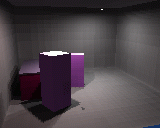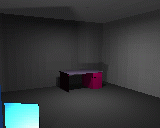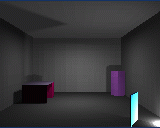
|

|

|

|
We have also investigated the potential benefits of computing a radiosity solution over a time interval, taking into account all object movements and changes in the scene, and refining the calculation to precisely reflect the resulting illumination changes. The expected benefit of such a system is the ability to compute high-quality time-dependent radiosity solutions, in cases where all animation parameters are known a priori. In this case, and in contrast to dynamic update solutions for interactive uses, it will be possible to use the knowledge of the trajectories and changes to ensure the absence of visually distracting artifacts.
While each and every frame of an animation must naturally be computed independently to reflect the appropriate position and parameters of the view at each time step, it seems promising to try and capitalize on the seemingly large temporal coherence in illumination, by computing lighting effects over a finite time range in a single calculation. Such solutions could, for instance, be computed to simulate subtle lighting effects (indirect lighting) in animation systems, or to obtain high-quality synthetic image sequences to blend with live action video and film.
We have therefore introduced a new hierarchical simulation algorithm allowing the calculation of radiosity solutions for time-dependent scenes, based on a Space-Time hierarchy, adding a life span to hierarchical surface elements, and an integrated formulation of Hierarchical Radiosity with this extended hierarchy. This algorithm has been integrated in iMAGIS' radiosity BRIGHT and is still under developpement. Our first results show that a short animation sequence can be computed rapidly at the price of a sizeable memory cost.
The discrete elements of our mesh are defined both by their geometrical description and their temporal description, the time interval of their validity, over which the radiosity is assumed constant. They can therefore be split either in space (e.g. in four sub-patches for quads and triangles) or in time (by dividing the time range, leaving the geometry unchanged). Therefore an element in our hierarchy can have children either in space or in time. With this hierarchical structure, the algorithm to solve the radiosity equation is the same as for classical hierarchical radiosity. From the original three parts composing an iteration (namely refine, push-pull, and gather), only the link refinement procedure needs specific changes in our case, because for the case where refinement is necessary, we need to know whether the elements' spatial or temporal extents are ``responsible'' for the inadequate representation, so as to be able to decide between time- and space-subdivision. This is currently done using a criterion based on estimates (samples) of the variation of the form factor over the patch surface and time range.
The given examples show the results we obtained for two short, simple animations (Movies in QuickTime).

|

|

|

|
More informations could be find in [DS99].